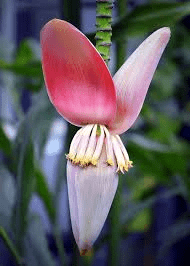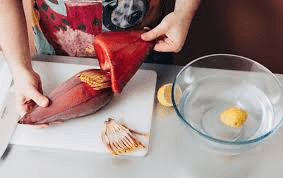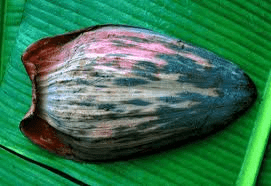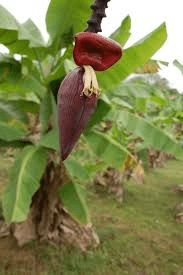Plantain bracts are specialized, leaf-like structures that play a crucial role in the development and protection of the plantain’s flowers and fruits. These bracts are part of the inflorescence, the flowering structure of the plantain, which emerges from the peduncle. Understanding the characteristics and functions of plantain bracts provides insight into their importance in the plantain’s life cycle.
Plantain bracts are large, modified leaves that can be quite striking in appearance. They are typically elongated, with a broad base that tapers to a point. The color of the bracts can vary, often starting as a deep purple or reddish hue and becoming more green as they age. This color change is influenced by the presence of pigments such as anthocyanins, which can provide protection against certain environmental stresses.
The texture of plantain bracts is generally tough and fibrous, which helps them fulfill their protective role. The outer surface may be smooth or slightly ridged, depending on the specific variety of plantain. Inside, the bracts are more tender and can sometimes be peeled back to reveal the developing flowers and fruits underneath.
One of the primary functions of plantain bracts is to protect the developing flowers and fruits. When the inflorescence first emerges from the peduncle, it is tightly enclosed within several layers of overlapping bracts. This protective enclosure helps shield the delicate flowers from physical damage, pests, and harsh environmental conditions such as intense sunlight or heavy rainfall.
As the flowers mature and begin to open, the bracts gradually peel back, exposing the flowers to pollinators. This exposure is crucial for the process of pollination, which is necessary for the fertilization of the flowers and subsequent fruit development. The bracts’ structure ensures that this exposure happens in a controlled manner, providing protection when needed and opening up at the right time to allow pollination.
In addition to their protective role, plantain bracts also have a role in nutrient storage and transport. The tissues within the bracts can store important nutrients and water, which can be utilized by the developing flowers and fruits. This storage capacity is particularly important in environments where nutrient availability may be limited.
Furthermore, the bracts help in the regulation of the plant’s growth and development. They produce certain hormones and signaling molecules that can influence the timing of flowering and fruiting. For example, the presence of bracts can affect the levels of auxins and gibberellins, hormones that regulate various aspects of plant growth, including the elongation of the peduncle and the development of the inflorescence.
Beyond their biological functions, plantain bracts have various practical applications. In some cultures, the bracts are harvested and used for culinary purposes. They can be cooked and eaten as a vegetable, providing a source of dietary fiber and nutrients. Additionally, the fibrous nature of the bracts makes them suitable for use in traditional crafts and industries. For example, they can be woven into mats, baskets, and other items.
Ecologically, plantain bracts contribute to the overall health of the plantain plant. By protecting the developing flowers and fruits, they help ensure successful reproduction and the continuation of the plantain species. The bracts also provide habitat and food for various insects and microorganisms, contributing to the biodiversity of the ecosystem.
In conclusion, plantain bracts are essential components of the plantain plant’s reproductive system. Their protective, nutritional, and regulatory roles make them vital for the successful development of flowers and fruits. Additionally, their practical applications and ecological significance highlight their importance beyond the plant itself. Understanding the structure and functions of plantain bracts provides valuable insights into the biology and cultivation of plantains.
The Economic Importance and Uses of Plantain Bracts

1. Animal Feed: Plantain bracts can be processed and used as feed for livestock. For example, they can be chopped and mixed with other feed ingredients to provide nutrition for cattle, goats, and poultry.
2. Organic Fertilizer: The fibrous material in the plantain bracts decomposes easily and can be used as organic fertilizer. Farmers often compost the bracts to improve soil fertility and structure.
3. Biofuel Production: Plantain bracts can be used to produce bioethanol, a renewable energy source. This involves fermentation and distillation processes to convert the biomass into ethanol fuel.
4. Handicrafts: The fibers from plantain bracts are used in making various handicrafts such as baskets, mats, and ropes. This provides income for artisans in rural areas.
5. Paper Production: Plantain bract fibers can be processed into paper. The cellulose content in the bracts makes it suitable for this purpose, providing an eco-friendly alternative to wood-based paper.
6. Medicinal Uses: In traditional medicine, plantain bracts are used to treat various ailments. For example, extracts are used to alleviate stomach issues and reduce inflammation.
7. Construction Material: The strong fibers of the plantain bracts can be used in the construction industry. They are used to reinforce building materials like bricks and cement blocks.
8. Mushroom Cultivation: The bracts serve as a substrate for mushroom cultivation. They provide the necessary nutrients and environment for mushroom growth.
9. Animal Bedding: Plantain bract fibers are used as bedding material for animals. They are absorbent and provide a comfortable resting place for livestock.
10. Biodegradable Packaging: Plantain bract fibers can be used to create biodegradable packaging materials, reducing reliance on plastic.
11. Textile Industry: The fibers can be spun into threads and used in the textile industry to make eco-friendly fabrics.
12. Biochar Production: When plantain bracts are subjected to pyrolysis, they produce biochar, which is used to enhance soil fertility and sequester carbon.
13. Water Filtration: The fibrous material can be used in water filtration systems to remove impurities, providing clean drinking water in rural areas.
14. Vermiculture: Plantain bracts are used in vermiculture to feed earthworms, which in turn produce high-quality vermicompost.
15. Fodder for Ruminants: In areas where forage is scarce, plantain bracts serve as an alternative fodder for ruminants like cows and sheep.
16. Craft Paper: The bract fibers are used to make craft paper, which is used for art projects and decorative purposes.
17. Eco-friendly Disposables: Plantain bract fibers are used to manufacture disposable plates, cups, and cutlery that are biodegradable.
18. Fish Feed: The bracts are processed into fish feed, providing an affordable and nutritious option for fish farmers.
Read Also: Snakes (venomous snakes): Description, Damages Caused, Control and Preventive Measures
The Products and By-products That Can Be Derived From Plantain Bracts

1. Fibers: Plantain bract fibers are extracted and used in making textiles, ropes, and handicrafts.
2. Bioethanol: The bracts are fermented and distilled to produce bioethanol, a renewable fuel.
3. Organic Fertilizer: Composting the bracts results in organic fertilizer for agriculture.
4. Paper: The cellulose content in the bracts is used to make paper.
5. Biochar: Pyrolysis of the bracts produces biochar, which is used for soil enhancement and carbon sequestration.
6. Animal Feed: Processed plantain bracts are used as feed for livestock and fish.
7. Handicrafts: The fibers are used to create various handicrafts like baskets and mats.
8. Mushroom Substrate: The bracts serve as a substrate for growing mushrooms.
9. Biodegradable Packaging: Fibers are used to make eco-friendly packaging materials.
10. Construction Material: The fibers reinforce building materials like bricks and cement blocks.
11. Water Filters: The fibrous material is used in water filtration systems.
12. Vermicompost: The bracts are used in vermiculture to feed earthworms for producing vermicompost.
13. Animal Bedding: The fibers provide comfortable bedding for livestock.
14. Craft Paper: Fibers are used to make decorative craft paper.
15. Eco-friendly Disposables: The bracts are used to manufacture biodegradable plates, cups, and cutlery.
16. Textiles: Fibers are spun into threads for making eco-friendly fabrics.
17. Medicinal Extracts: Extracts from the bracts are used in traditional medicine to treat various ailments.
Read Also: The Appearance and Features of Water Snakes
Frequently Asked Questions (FAQ’s) About Plantain Bracts

1. What are plantain bracts? Plantain bracts are the modified leaves that cover and protect the developing plantain flowers and fruit.
2. How can plantain bracts be used in agriculture? They can be composted into organic fertilizer to improve soil fertility.
3. Are plantain bracts edible? While the fruit is edible, the bracts themselves are typically not consumed but used in other applications like animal feed and composting.
4. How are plantain bracts processed into bioethanol? They are fermented and distilled to produce ethanol fuel.
5. Can plantain bracts be used in construction? Yes, their fibers are used to reinforce building materials like bricks and cement blocks.
6. What handicrafts can be made from plantain bracts? Items like baskets, mats, and ropes can be crafted from the fibers.
7. How do plantain bracts benefit mushroom cultivation? They provide a nutrient-rich substrate for mushroom growth.
8. Are plantain bracts used in traditional medicine? Yes, extracts from the bracts are used to treat ailments such as stomach issues and inflammation.
9. How do plantain bracts contribute to environmental sustainability? They are used to make biodegradable packaging, reducing plastic waste.
10. Can plantain bracts be used as animal feed? Yes, they can be processed and mixed with other ingredients to provide nutrition for livestock and fish.
Read Also: Top 20 Proven Benefits of Ginger Plant

